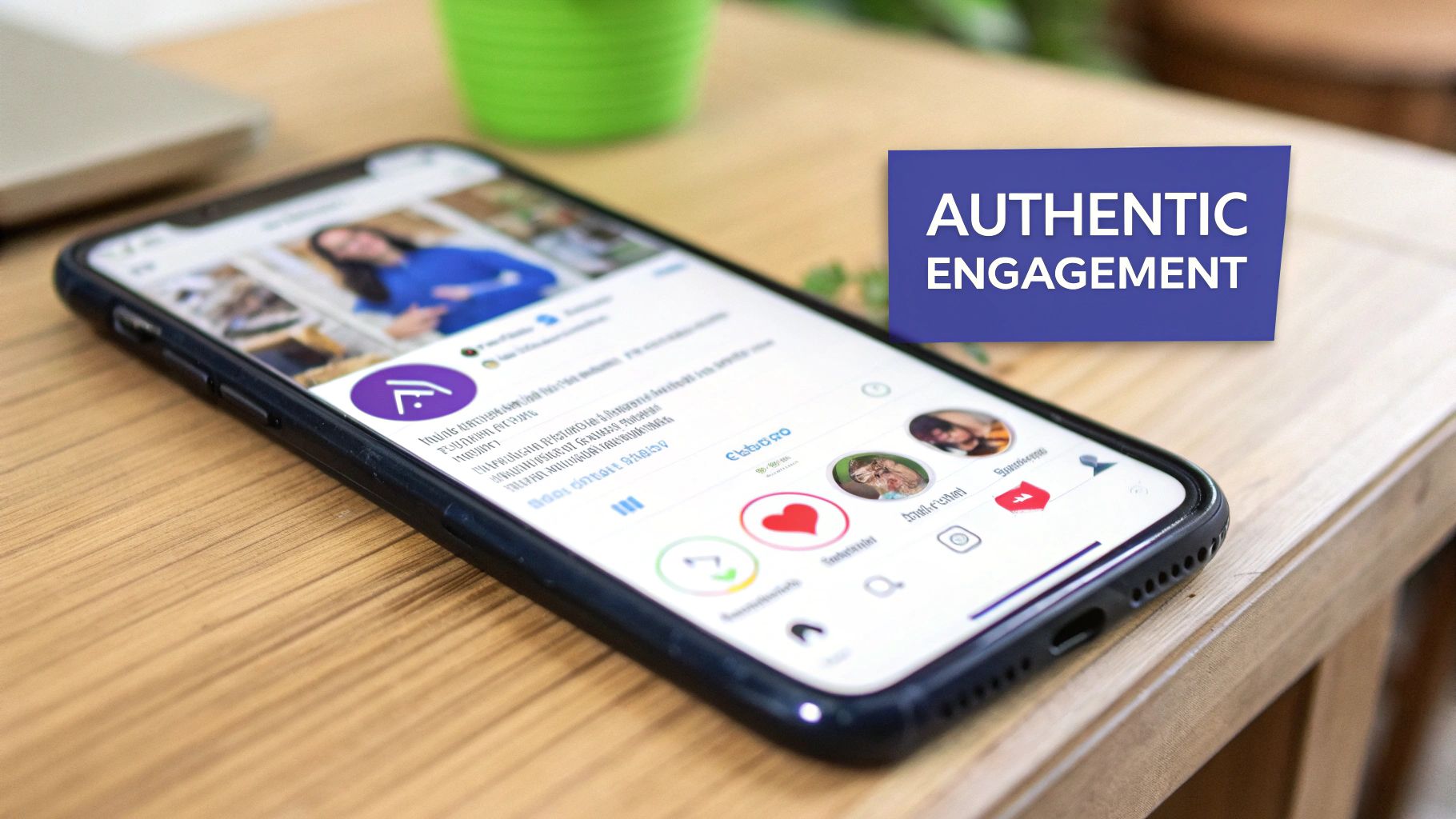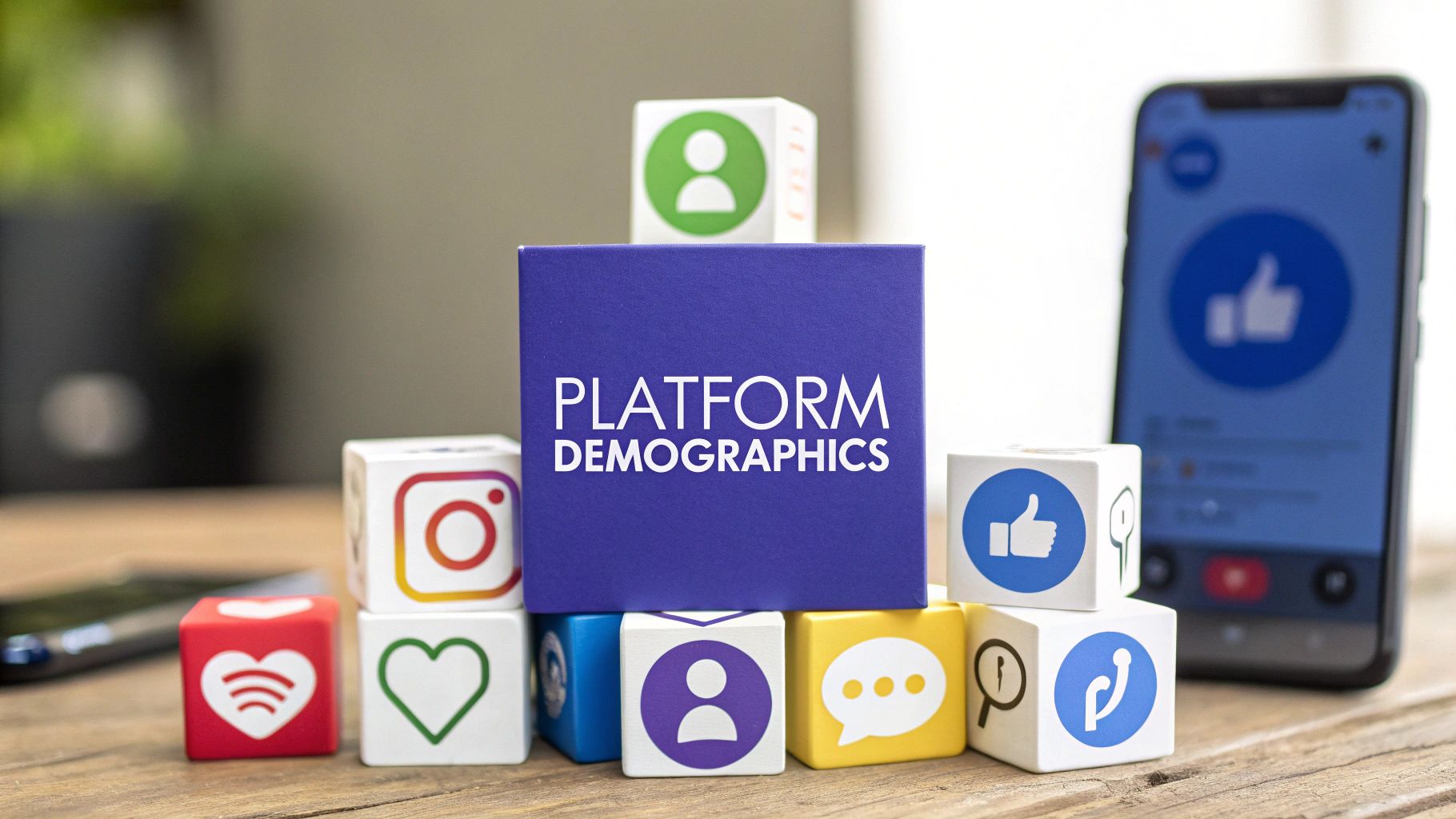In today's crowded digital landscape, simply having social media profiles isn't enough. Effective social media management is the engine that drives engagement, builds brand loyalty, and delivers tangible business results. It transforms random posts into a cohesive strategy and passive followers into an active community. But navigating the ever-changing algorithms, audience expectations, and platform features can feel overwhelming. That’s why we’ve compiled the most critical social media management tips to help you cut through the noise.
This guide moves beyond generic advice to provide actionable, data-backed strategies designed to streamline your workflow, boost your online presence, and achieve your marketing goals. We will cover everything from developing a consistent content strategy and knowing your audience through data analytics to leveraging platform-specific tactics and mastering authentic engagement. Whether you are a solo creator, a small business, or part of a large agency, these tips will equip you to manage your social channels with confidence and precision. You'll learn how to implement these techniques for immediate impact, turning potential chaos into a high-performing, cohesive social media operation. Let’s dive into the strategies that will define your success.
1. Develop a Consistent Content Strategy
Effective social media management begins long before you hit “publish.” It starts with a deliberate, consistent content strategy that acts as a blueprint for every post, story, and video you share. This strategy ensures your content is not just random noise but a cohesive narrative that reinforces your brand identity, speaks directly to your audience, and drives specific business goals. A well-defined plan helps you build brand recognition, foster trust, and keep your followers engaged with a predictable yet valuable stream of content.

Think of industry leaders who have mastered this. Nike consistently uses motivational and aspirational messaging, while HubSpot focuses on educational content to generate leads. Developing a robust content strategy is the backbone of successful social media management, ensuring your efforts are targeted and impactful. For those looking to dive deeper into this foundational topic, exploring various effective content marketing strategies can provide a comprehensive framework for building a plan that truly resonates and stops you from wasting your budget.
Actionable Steps for Implementation
To build a strategy that works, move from abstract goals to concrete actions. Follow these steps to create a plan you can execute consistently.
- Define Your Content Pillars: Select 3-5 core themes or topics that your brand will own. These pillars should be relevant to your audience's interests and your business expertise. For a fitness brand, pillars might be Workout Tips, Healthy Recipes, and Mindfulness.
- Establish a Content Calendar: Plan your content at least 30 days in advance. This forethought prevents last-minute scrambling and allows for more strategic, higher-quality posts. Use a tool like PostSyncer to schedule posts across all platforms from one central hub.
- Apply the 80/20 Rule: Dedicate 80% of your content to providing value, such as education, entertainment, or inspiration. Reserve the remaining 20% for direct promotional messages, like sales announcements or product features. This balance prevents audience fatigue and builds a loyal community.
2. Know Your Audience Through Data Analytics
Effective social media management is impossible without a deep understanding of who you're talking to. Moving beyond surface-level demographics, a data-driven approach allows you to uncover behavioral patterns, content preferences, and optimal engagement times. This analytical insight is crucial for crafting content that truly resonates, turning passive followers into an active community. By leveraging analytics, you transform guesswork into a predictable strategy that delivers measurable results and a higher return on your efforts.

Consider how major brands use this to their advantage. Netflix's content recommendations are so precise they spark widespread social media conversations, while Spotify's personalized "Wrapped" campaigns turn user data into highly shareable content. These companies don't just guess what their audience wants; they know, because the data tells them. Adopting this analytical mindset is one of the most powerful social media management tips for sustainable growth. To get started, it's essential to become familiar with the best social media analytics tools available to gather these critical insights.
Actionable Steps for Implementation
Translate raw data into a clear audience profile and content strategy with these practical steps. This process ensures your decisions are based on evidence, not assumptions.
- Create Data-Driven Personas: Go beyond basic demographics. Use analytics to identify your audience's interests, online behaviors, and the type of content they share most. Combine this with their age, location, and language to build detailed personas that guide your content creation.
- Conduct Weekly Analytics Reviews: Make data review a non-negotiable weekly task. Use each platform’s native tools, like Facebook Insights or Twitter Analytics, to monitor key metrics such as reach, engagement rate, and click-throughs. Look for patterns in what works and what doesn't.
- A/B Test Your Content: Don't assume you know what your audience prefers. Systematically test different content formats (e.g., video vs. carousel), captions (e.g., short vs. long), and visuals to see what generates the best response. Use these findings to refine your content pillars and daily posts.
3. Engage Authentically and Respond Promptly
Social media is not a broadcast channel; it's a two-way conversation. Authentic engagement means moving beyond simply posting content and actively participating in the community you’ve built. It involves genuine, human interactions like responding to comments, answering direct messages, and acknowledging mentions promptly. This dialogue humanizes your brand, transforming it from a faceless entity into a relatable presence that builds trust, fosters loyalty, and encourages organic advocacy.

Brands like Wendy's have famously used witty, responsive Twitter interactions to build a cult following, while Patagonia reinforces its brand values by engaging in conversations around environmental activism. These examples prove that one of the most powerful social media management tips is to simply listen and talk back. Treating every interaction as an opportunity to strengthen a relationship is what separates successful brands from those that just shout into the void. This approach turns passive followers into an active, invested community.
Actionable Steps for Implementation
To make authentic engagement a core part of your strategy, you need a system that ensures timeliness and personalization. Follow these steps to turn interactions into lasting connections.
- Establish Response Time Benchmarks: Aim to respond to all comments and direct messages within a few hours during business days. Promptness shows your audience that you value their input and are actively listening. Use a unified inbox, like the one in PostSyncer, to consolidate messages from all platforms and ensure nothing gets missed.
- Develop a Brand Voice, Not a Robot Voice: While maintaining a consistent brand tone is important, avoid canned, robotic replies. Personalize responses by using the person’s name and referencing their specific comment or question. Empower your team to be human, show empathy, and even use humor where appropriate.
- Handle Negative Feedback with Grace: Address negative comments or complaints professionally and publicly at first to show you are responsive. Acknowledge the issue and then offer to move the conversation to a private channel like DMs or email to resolve it. This demonstrates transparency and a commitment to customer satisfaction.
4. Utilize Visual Content and Video Marketing
In the fast-scrolling world of social media, text-only posts are easily overlooked. Visual content, including high-quality images, infographics, and especially video, is no longer optional; it's a fundamental requirement for capturing attention. Platforms like Instagram, TikTok, and YouTube have conditioned users to expect dynamic, visually engaging content, making video marketing one of the most effective social media management tips for driving engagement and conveying messages quickly.

Think of Tasty's viral recipe videos, which transformed simple instructions into highly shareable entertainment, or National Geographic's breathtaking photography that tells compelling stories without a single word. These brands prove that strong visuals create an immediate emotional connection and stop users mid-scroll. To truly master the visual landscape, dive into a comprehensive guide on video marketing for social media to learn strategies that convert viewers into loyal followers.
Actionable Steps for Implementation
Transform your feed from text-heavy to visually stunning with these practical steps. A consistent visual identity will make your brand instantly recognizable.
- Create Branded Templates: Use tools like Canva or Adobe Express to design templates for recurring content types like quotes, tips, or announcements. This ensures brand consistency and significantly speeds up content creation.
- Optimize Video for Each Platform: Tailor your video length and format to the platform. Keep it under 60 seconds for Instagram Reels, 15-30 seconds for TikTok, and reserve longer-form content for YouTube. Always add captions, as many users watch videos without sound.
- Prioritize High-Quality Imagery: Invest in good photography or use high-resolution stock images. Blurry or poorly composed visuals can damage your brand's credibility. Always include descriptive alt-text to make your content accessible to visually impaired users.
5. Leverage Social Media Management Tools
Manually posting across multiple social media platforms is not only time-consuming but also prone to inconsistency and error. Leveraging social media management tools is a non-negotiable tip for anyone serious about growing their online presence efficiently. These platforms act as a central command center, allowing you to create, schedule, publish, and analyze content from one dashboard, saving countless hours and ensuring a cohesive brand message across all channels. They transform social media from a chaotic daily task into a streamlined, strategic operation.
Think of how large brands maintain a constant, high-quality presence. They aren't logging into each app multiple times a day; they use sophisticated tools like Sprout Social or Hootsuite. Similarly, agile small businesses and creators rely on platforms like Buffer or Later to plan visually compelling feeds and maintain consistency without being tethered to their devices. Adopting one of these tools is a fundamental step in professionalizing your social media efforts and reclaiming valuable time. For those ready to explore their options, understanding the nuances of different social media scheduling software is the perfect starting point to find a tool that fits your workflow.
Actionable Steps for Implementation
To get the most out of these powerful platforms, you need to integrate them thoughtfully into your workflow. Follow these steps to maximize your efficiency and impact.
- Choose the Right Tool for Your Needs: Start by evaluating your primary needs. Are you Instagram-focused? A tool like Later excels at visual planning. Do you manage multiple clients? PostSyncer offers robust team collaboration and approval workflows. Test free trials or plans to see which interface feels most intuitive before committing.
- Schedule in Batches but Engage in Real-Time: Use your tool to batch-schedule your core content for the week or month ahead. This frees you up to focus on what truly matters: real-time engagement. While posts go out automatically, dedicate daily time to respond to comments, answer messages, and participate in relevant conversations manually.
- Use Analytics to Refine Your Strategy: The best social media management tools provide powerful analytics. Regularly review performance reports to identify your best-performing content, optimal posting times, and audience growth trends. Use these data-driven insights to continually refine your content pillars and scheduling for better results.
6. Monitor Your Online Reputation and Social Listening
Effective social media management extends beyond what you post; it also involves listening to what others are saying about you. Social listening is the process of tracking mentions of your brand, competitors, and relevant keywords across social platforms. This practice allows you to understand public sentiment, proactively manage your online reputation, and uncover valuable market insights that might otherwise go unnoticed. It’s the difference between speaking at your audience and having a meaningful conversation with them.
Think about how major airlines use social listening to resolve customer service issues in real-time or how McDonald’s tracks sentiment during a new product launch to gauge success. By actively monitoring these conversations, you can address negative feedback before it escalates, amplify positive mentions, and stay ahead of industry trends. This proactive approach is one of the most powerful social media management tips for maintaining a healthy brand image. Platforms like Brandwatch and Mention have popularized this strategy, making sophisticated monitoring accessible to businesses of all sizes.
Actionable Steps for Implementation
To turn social listening from a passive activity into a strategic advantage, follow these concrete steps to monitor and engage with your community effectively.
- Set Up Keyword and Brand Alerts: Start by tracking your brand name, common misspellings, and key product names. Use PostSyncer's monitoring features or free tools like Google Alerts to receive notifications whenever these terms are mentioned online. This is your first line of defense in reputation management.
- Monitor Competitor Mentions: Pay attention to what people are saying about your competitors. Are customers complaining about a specific feature? Are they praising a new campaign? This intelligence can reveal gaps in their offerings that your brand can fill, providing a direct competitive advantage.
- Establish Response Protocols: Create a clear plan for how your team will respond to different types of mentions. Define a process for handling negative feedback, a way to thank users for positive shoutouts, and a method for escalating urgent customer service inquiries. This ensures a consistent and professional brand voice.
7. Optimize Posting Times and Frequency
Publishing great content is only half the battle; ensuring it reaches your audience at the right moment is what separates a good post from a viral one. Optimizing your posting times and frequency means analyzing when your followers are most active and tailoring your schedule to these peak engagement windows. This strategic approach ensures your content doesn't get buried in the feed but instead appears when users are most likely to see, like, comment on, and share it. By aligning your posting schedule with audience behavior, you maximize visibility and engagement for every piece of content you create.
This tactic is a cornerstone of effective social media management, with research from industry leaders like Sprout Social and Buffer consistently proving its impact. For example, B2B companies often find their highest engagement on LinkedIn during weekday business hours when professionals are most active. In contrast, an entertainment brand might see its best results on TikTok during evening hours and weekends. Mastering this element of your strategy is a powerful way to boost organic reach and improve your overall performance without increasing your content creation workload.
Actionable Steps for Implementation
Transform audience data into a high-impact posting schedule. Follow these steps to find the sweet spot for your brand’s content delivery.
- Analyze Your Platform Analytics: Dive into the native analytics on Instagram, Facebook, and other platforms. Most provide detailed reports showing the days and hours your followers are most active. Use this data as your starting point for scheduling.
- Test and Measure Relentlessly: Your initial data is a hypothesis, not a rule. Test different posting times for a consistent 2-4 week period. For instance, try posting at 9 AM one week and 1 PM the next, then compare the engagement metrics to identify your unique peak windows.
- Adapt Frequency by Platform: Not all platforms require the same posting cadence. A general best practice is to post 3-5 times per week on Instagram, 1-3 times per day on Facebook, and 5+ times per day on Twitter/X. Adjust based on your audience’s response and your ability to produce high-quality content. Using a tool like PostSyncer allows you to pre-set these different cadences, ensuring consistency across all channels from a single dashboard.
8. Create Platform-Specific Content Strategies
One of the most common pitfalls in social media management is treating all platforms as a single, homogenous channel. Effective management requires recognizing that each network has a distinct audience, unique content formats, and different user expectations. A one-size-fits-all approach, where the same post is blindly cross-posted everywhere, dilutes your message and signals a lack of understanding. Tailoring your content to fit the native environment of each platform is crucial for maximizing reach, engagement, and overall impact.
This strategic adaptation ensures your content feels natural and relevant, not forced or out of place. For instance, what captivates an audience on TikTok, with its fast-paced, trend-driven videos, will likely fall flat on the professionally-oriented, text-heavy landscape of LinkedIn. Mastering this nuanced approach is one of the most vital social media management tips for building an authentic connection with diverse audience segments across the digital ecosystem.
Think of how major brands execute this. Adobe uses Instagram to showcase visually stunning user-generated art and creative inspiration, while its LinkedIn feed is dedicated to professional tutorials, industry insights, and corporate news. This platform-specific strategy allows them to connect with different facets of their audience in the most effective context, building a stronger, more holistic brand presence.
Actionable Steps for Implementation
To move beyond generic cross-posting and start creating content that truly performs, tailor your core message to each platform’s unique strengths.
- Adapt a Single Idea into Native Formats: Take one core concept, like a new product launch, and create platform-specific versions. For Instagram, create a visually appealing Reel and a high-quality carousel post. For LinkedIn, write a detailed article about the problem it solves. For TikTok, produce a short, trend-based video showing it in action.
- Leverage Platform-Specific Features: Go beyond standard posts and utilize the unique tools each network offers. Use Instagram Stories polls to gather audience feedback, host a live Q&A with Twitter Spaces to connect directly with followers, or create an in-depth guide on Facebook to provide educational value.
- Research Platform-Specific Trends and Hashtags: What trends on TikTok won't necessarily trend on Twitter. Invest time in researching what is currently popular on each platform. Use platform-specific hashtag research tools to identify relevant, high-traffic tags instead of copying and pasting the same set everywhere. PostSyncer’s AI can even suggest platform-optimized captions and hashtags, simplifying this process.
8 Key Social Media Management Tips Compared
| Strategy/Approach | Implementation Complexity 🔄 | Resource Requirements ⚡ | Expected Outcomes 📊 | Ideal Use Cases 💡 | Key Advantages ⭐ |
|---|---|---|---|---|---|
| Develop a Consistent Content Strategy | Medium - requires upfront planning and updates | Moderate - content creators, planners | Strong brand recognition, increased engagement | Brands aiming for long-term audience loyalty and predictable messaging | Builds brand identity, streamlines creation |
| Know Your Audience Through Data Analytics | High - involves data gathering and analysis | High - analytical tools, skilled analysts | Targeted content, better ROI, improved customer satisfaction | Data-driven teams focusing on precise targeting and content optimization | Enhanced targeting, actionable insights |
| Engage Authentically and Respond Promptly | Medium to high - continuous monitoring needed | High - dedicated community managers | Stronger relationships, increased loyalty, feedback | Customer-focused brands prioritizing trust and real-time interaction | Builds trust, improves engagement |
| Utilize Visual Content and Video Marketing | High - requires creative skills and equipment | High - video/graphic design resources | Higher engagement, better retention, shares | Brands leveraging storytelling and trending short-form video platforms | Significantly boosts engagement and shareability |
| Leverage Social Media Management Tools | Low to medium - learning curve for tools | Moderate - subscription fees, training | Time saved, consistent scheduling, better analytics | Teams managing multiple platforms needing automation and collaboration | Saves time, improves coordination |
| Monitor Online Reputation & Social Listening | Medium to high - requires monitoring & analysis | Moderate to high - tools and analysts | Early issue detection, competitive insights | Brands focused on reputation management and proactive customer service | Prevents crises, gathers valuable feedback |
| Optimize Posting Times and Frequency | Medium - requires ongoing testing and adjustment | Low to moderate - analytics tools | Increased reach and engagement, avoids fatigue | Brands wanting to maximize organic performance and audience attention | Maximizes visibility and engagement |
| Create Platform-Specific Content Strategies | High - requires expertise per platform | High - knowledge and diverse content creation | Higher engagement and authenticity per platform | Multi-platform brands tailoring content to platform formats & audiences | Optimizes performance, authentic connections |
Master Your Social Media, Master Your Growth
Navigating the dynamic landscape of social media can feel like a monumental task, but the path to mastery is built on a foundation of strategic, consistent action. Throughout this guide, we've explored a comprehensive suite of social media management tips, moving beyond generic advice to provide a clear, actionable blueprint for success. From the critical first step of developing a cohesive content strategy to the nuanced art of creating platform-specific content, each tip serves as a vital cog in a much larger machine.
The core takeaway is that effective management is not a single action but an integrated system. It’s about creating a powerful feedback loop where data-driven audience insights inform your content, authentic engagement builds community, and vigilant reputation monitoring protects your brand. You cannot excel in one area while neglecting the others. A brilliant content strategy will falter without optimized posting times, and prompt community engagement loses its impact if it isn't authentic.
From Knowledge to Actionable Strategy
Your journey doesn't end with reading these tips; it begins with implementing them. To truly transform your social media presence from a daily chore into a strategic growth engine, focus on these key pillars:
- Data-Informed Decisions: Move away from guesswork. Use the analytics and social listening tools at your disposal to understand what truly resonates with your audience. Let this data guide every choice, from the content you create to the times you post.
- Authentic Human Connection: Remember that behind every screen is a person. Prioritize genuine engagement, respond with empathy, and strive to build a loyal community, not just a follower count. This human element is your most sustainable competitive advantage.
- Strategic Efficiency: Your time is your most valuable asset. Leveraging a powerful social media management tool is no longer a luxury but a necessity for executing a sophisticated strategy without burning out. Centralizing your workflow allows you to focus on high-impact activities.
Mastering these concepts means more than just earning likes and shares; it means building tangible business value. It leads to enhanced brand loyalty, increased lead generation, and a direct impact on your bottom line. By consistently applying these social media management tips, you are not just posting online; you are building a powerful, predictable engine for growth.
Ready to turn these expert strategies into effortless execution? PostSyncer provides the all-in-one command center you need to schedule, analyze, and manage your entire social presence with unparalleled efficiency. Start your free trial of PostSyncer today and unlock the full potential of your social media.















